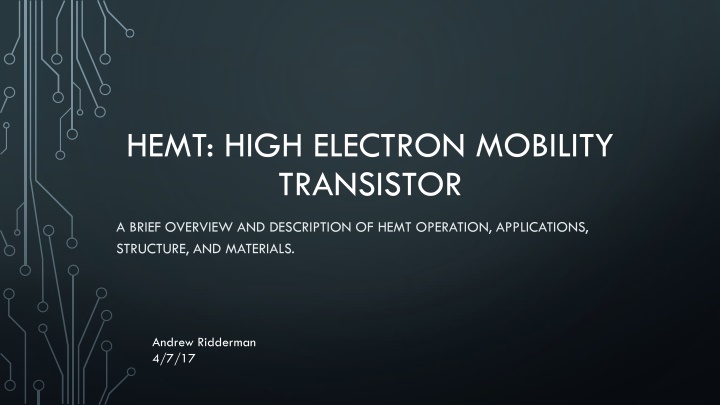
HEMT: Operation, Applications, and Structure
Learn about High Electron Mobility Transistors (HEMTs) - their operation, materials, characteristics, and applications in wireless communications like cellphones and WLAN. Explore different versions of HEMTs like PHEMT and MHEMT, and understand the advantages and challenges they bring to modern electronics.
Uploaded on | 6 Views
Download Presentation

Please find below an Image/Link to download the presentation.
The content on the website is provided AS IS for your information and personal use only. It may not be sold, licensed, or shared on other websites without obtaining consent from the author. If you encounter any issues during the download, it is possible that the publisher has removed the file from their server.
You are allowed to download the files provided on this website for personal or commercial use, subject to the condition that they are used lawfully. All files are the property of their respective owners.
The content on the website is provided AS IS for your information and personal use only. It may not be sold, licensed, or shared on other websites without obtaining consent from the author.
E N D
Presentation Transcript
HEMT: HIGH ELECTRON MOBILITY TRANSISTOR A BRIEF OVERVIEW AND DESCRIPTION OF HEMT OPERATION, APPLICATIONS, STRUCTURE, AND MATERIALS. Andrew Ridderman 4/7/17
OUTLINE Introduction What are HEMT s and how do they work? Materials and structure Characteristics and band diagram Versions of HEMT s Applications Summary and Conclusions References Key Concepts
INTRODUCTION Invention of the HEMT is attributed to Takashi Mimura HEMTs were first investigated in 1969 but were not implemented in a device until 1980 initially with a very high cost Today the largest market for HEMT integrated circuits are wireless communications such as cellphones, WLAN, and CATV
WHAT ARE HEMTS AND HOW DO THEY WORK? Field-Effect transistor which uses a hetrojunction as the channel instead of a doped region The hetrojunction forms a quantum well in the conduction band forcing electrons to an undoped region where electrons can move without colliding with impurities When a voltage > ?? is applied to the gate electrons accumulate to form a 2D high mobility electron gas
MATERIALS AND STRUCTURE The most common materials used for HEMTs are GaAs and AlGaAs However InP and GaN are also used in some cases for improved characteristics The spacer layer seperates the 2DEG from any ionized donors increasing mobility
CHARACTERISTICS AND BAND DIAGRAM HEMT characteristics include high gain, high switching speed, low noise and very good high frequency performance Cutoff frequencies of 100GHz+ have been achieved Higher mobility of HEMT also results in lower parasitic drain and source resistances The biggest disadvantage of the HEMT is heterojunction fabrication is more complicated
VERSIONS OF HEMTS PSEUDOMORPHIC (PHEMT) Uses an extremely thin layer of one of the materials so that the crystal lattice stretches to fit the other material Allows for larger bandgap differences resulting in better performance METAMORPHIC (MHEMT) Uses a buffer layer of to match the lattice of constant of both materials Different Indium concentrations can be used to optimize the device for different applications
APPLICATIONS Originally developed for high speed applications Used in a wide range of RF applications including Microwave and millimeter wave communications, imaging, radar, and astronomy Used in military and space applications such as electronic warfare systems and satellite communication Applications where high frequencies, high gain and low noise are required GaN HEMT is widely used in small signal amps, power amps, and oscillators because of its low on-state resistance and high switching speed
SUMMARY AND CONCLUSIONS HEMTs can operate a high frequency by utilizing the 2DEG created by the hetrojunction which result in a very high electron mobility. The high frequencies and low noise achievable with HEMTs are great for high bandwidth RF communication applications. Different structure designs such as PHEMT and MHEMT further improve upon the standard HEMTs performance resulting in more desirable characteristics.
REFERENCES http://www.radio-electronics.com/info/data/semicond/fet-field-effect-transistor/hemt-phemt-transistor.php https://parts.jpl.nasa.gov/mmic/3-IV.PDF http://www.ee.sc.edu/personal/faculty/simin/ELCT871/18%20AlGAN-GaN%20HEMTs.pdf https://www.fujitsu.com/global/documents/about/resources/publications/fstj/archives/vol50-1/paper21.pdf http://www.iue.tuwien.ac.at/phd/brech/ch_6_2_2.htm http://my.ece.ucsb.edu/Mishra/classfiles/overview.pdf http://www.nrao.edu/meetings/isstt/papers/2009/2009178182.pdf https://ocw.mit.edu/courses/electrical-engineering-and-computer-science/6-772-compound-semiconductor- devices-spring-2003/lecture-notes/Lecture12v2.pdf http://science24.com/paper/12263 http://www-mtl.mit.edu/~alamo/pdf/2011/RC-189%20slides.pdf
KEY CONCEPTS 2DEG has such a high mobility due to the channel layer having no dopant impurities HEMT s are mostly used in high performance applications where high frequency and low noise are needed A heterojunction is a junction between materials with different band gaps HEMT s can be used in a large range of frequencies allowing for use in many different applications The most used materials for HEMTs are GaAs and AlGaAs
